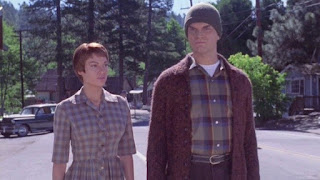 |
| WandaVision "The Series Finale" |
A common sentiment among MCU fans for years is that these characters are so strong, hangout stories with no action would be welcomed.
WandaVision goes some way toward fulfilling that notion, but in its series finale, action comes crashing through the town of Westview. It's an almost jarring development, seeing so many powered characters exercising their abilities in combat, after so much of the season playing out sitcom tropes. And after the dust settles, "The Series Finale" wraps up the series with a poignant bow.
A lot of magic is exercised and changes hands in the episode. Wanda and Agatha take their magical duels to the skies, and in another pairing of power sets, Wanda's simulacra Vision and the white "sentient weapon" Vision also cut across the sky. Agatha absorbs Wanda's powers to varying degrees, emphasizing her belief that Wanda doesn't deserve her magic.
But Wanda's magic is galvanized, and she levels up once again. She gains a new costume a little more reminiscent of her comics outfit, and ends up trapping Agatha in the Agnes sitcom character. During the fireworks that make up their witches' battle, Wanda throws a car like in Captain America: Civil War. And for the first time since Avengers: Age of Ultron, Wanda breaks out her old undercranked walk-up mind manipulation!
Speaking of that movie, the two Visions' Ship of Theseus conversation cannot help but recall the wonderful philosophical discussion between Vision and Ultron in the Sokovian forest. Both Visions are shades and echoes of the original, while still retaining some essence of him. Both wield a mere approximation of the Mind Stone. Wanda's Vision achieves the classic Star Trek victory of using logic kung fu on a computer, and the white Vision flies to parts unknown.
Elsewhere, S.W.O.R.D. director Hayward begins an acquaintance with his comeuppance, after Darcy intercepts him. Her "have fun in prison!" is perfectly in character. As if to give Hayward's villainy a coup de grace, he sees two kids and his first instinct is to shoot them. Some of his bullets are ameliorated by Monica and her new "photonic" powers. As with Luke Cage, there is a loaded quality to a Black superhero with an immunity to bullets.
Monica uncovers that Evan Peters' Pietro is in fact a Westview resident bewitched by Agatha - the plot thickens for mutants coming into the MCU. The townsfolk regain their memories and confront Wanda, which proves quite uncomfortable for them. What is with Disney+ heroes and inadvertent magical choking? First Grogu, and now Wanda. In the aftermath, the people of Westview understandably look at Wanda with resentment, and Wanda and Monica's conversation brings a measure of closure to this disquieting aspect of the show. It's a tearjerking moment when Monica wonders as to the lengths she would go to be with her mother again.
More emotional moments are in store when it comes time for Wanda to say goodbye to Tommy, Billy, and Vision. In a poignant monologue, Vision reflects on the different forms he's taken, which also functions from Paul Bettany's perspective. The "voice without a body", referring to Jarvis, is a reminder of how far Bettany has come in the MCU.
And WandaVision has come far as a show, in the finest tradition of multi-layered storytelling. The sitcom pastiche is a gimmick, but also one directly springing out of Wanda's childhood nostalgia. That word, nostalgia, means the pain of remembering home. A home that was destroyed by a Stark Industries warhead, always in her thoughts as Wanda built a new home in New Jersey. And now in a new chapter of her life, Wanda's rich story continues as her pain grows alongside her power. And over the course of this season, she has begun to process that pain. 7/10.
Stray observations:
- Time for some Darkhold talk. This "book of the damned" has information on the legendary figure of the Scarlet Witch, including her apparent destiny to destroy the world - whatever that may come to mean. It made its screen debut in Agents of S.H.I.E.L.D., connected to a Ghost Rider storyline. Later, Wanda is seen isolated in a cabin in a beautiful valley, Edward Norton Bruce Banner style. She's researching the Darkhold, presumably for a possible avenue for her children to live again. Significantly, a strain of Michael Giacchino's Doctor Strange theme plays over Wanda's research, probably setting up their team-up in Doctor Strange in the Multiverse of Madness. But as to the provenance of the Darkhold, this is an extremely rare occurrence of an element from pre-WandaVision Marvel TV crossing over into the "mainstream" MCU, as opposed to the reverse.
- There are two allusions to The Wizard of Oz. Agatha's boots are seen under the car like she's the Wicked Witch of the East. And the movie theater marquee shows Oz the Great and Powerful playing, featuring Black Widow star Rachel Weisz, as that same Wicked Witch of the East!
- The white Vision's Mind Stone beam is colored blue, to differentiate from the other Vision. This is reminiscent of wight Viserion's blue fire breath in the latter episodes of Game of Thrones.
- The mid-credits scene features a Skrull making contact with Monica, making reference to an "old friend" of Maria Rambeau. That's got to be either Talos or Nick Fury inviting Monica to space.
- Paul Bettany has appeared in the first installment of all four MCU "phases". Iron Man (One), Iron Man 3 (Two), Captain America: Civil War (Three), WandaVision (Four).


























